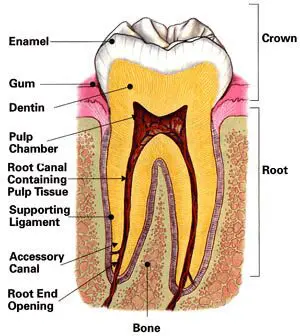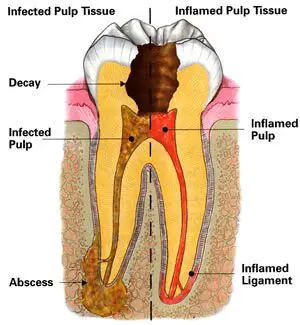Frequently Asked Questions
Here at Westchester Endodontic Care, we place emphasis on the well-being of our patients by addressing any concerns before treatment is rendered. Our staff is here to answer any of your questions, big or small. We believe that empowering our patients with knowledge and understanding of the process and reason for endodontic treatment is a part of creating a pleasant experience for our patients. The following are some frequently asked questions about endodontics and our practice.

“Endo” is the Greek word for “inside,” and “odont” is Greek for “tooth.” Endodontic treatment treats the inside of the tooth.
To understand endodontic treatment, it helps to know something about the anatomy of a tooth. Inside the tooth, under the white enamel and a hard layer called the dentin, is a soft tissue called the pulp. The pulp contains blood vessels, nerves, and connective tissue and creates the surrounding hard tissue of the tooth during development.
The pulp extends from the crown of the tooth to the tip of the roots, where it connects to the tissues surrounding the root. The pulp is important during a tooth’s growth and development. However, once a tooth is fully mature, it can survive without the pulp because the tooth continues to be nourished by the tissue surrounding it.

Endodontic treatment is necessary when the pulp becomes inflamed or infected. The inflammation or infection can have a variety of causes; deep decay, repeated dental procedures on the tooth, or a crack or chip in the tooth. In addition, a blow to a tooth may cause pulp damage even if the tooth has no visible chips or cracks. If pulp inflammation or infection is left untreated, it can cause pain or lead to an abscess.
Signs of pulp damage include pain, prolonged sensitivity to heat or cold, discoloration of the tooth, and swelling and tenderness in the nearby gums. Sometimes, there are no symptoms.
The pulp extends from the crown of the tooth to the tip of the roots, where it connects to the tissues surrounding the root. The pulp is important during a tooth’s growth and development. However, once a tooth is fully mature, it can survive without the pulp because the tooth continues to be nourished by the tissue surrounding it.
All dentists, including your general dentist, received training in endodontic treatment in dental school. General dentists can perform endodontic procedures along with other dental procedures, but often they refer patients needing endodontic treatment to endodontists.
Endodontists are dentists with special training in endodontic procedures. They do only endodontics in their practices because they are specialists. To become specialists, they complete dental school and an additional three or more years of advanced training in endodontics. They perform routine as well as difficult and very complex endodontic procedures, including endodontic surgery. Endodontists are also experienced in finding the cause of oral and facial pain that has been difficult to diagnose.
The endodontist removes the inflamed or infected pulp, carefully cleans and shapes the inside of the tooth, then fills and seals the space. Afterward, you will return to your dentist, who will place a crown or other restoration on the tooth to protect and restore it to full function. After restoration, the tooth continues to function like any other tooth.
Many endodontic procedures are performed to relieve the pain of toothaches caused by pulp inflammation or infection. With modern techniques and anesthetics, most patients report that they are comfortable during the procedure.
Insect bites, burns, scrapes, and cuts; all of these will produce inflammation of the skin characterized by redness (an increase in the blood flow to the area) and therefore swelling.
Removal of pulp tissue from a root canal can produce inflammation in the socket holding the tooth. Unlike our skin which can expand, increased fluid in bone produces pressure on sensitive structures like the membranes of our sinuses or large nerve structures in our jaw.
All inflammation takes 7 to 10 days to disappear (think how long a cold lasts). For the first few days after treatment, your teeth may feel sensitive, especially if there was pain or infection before the procedure. This discomfort can be relieved with over-the-counter or prescription medications. Follow your endodontist’s instructions carefully. Your tooth may continue to feel slightly different from your other teeth for some time after your endodontic treatment is completed. However, if you have severe pain or pressure or pain that lasts more than a few days, please feel free to contact our office at (914) 698-6811 so that we may check the progress of your healing.
Root canal therapy has been reported to be up to 95% successful. Many factors influence the treatment outcome: the patient’s general health, bone support around the tooth, the strength of the tooth, including possible fracture lines, shape and condition of the root and nerve canal(s), and continued follow-up care with your general dentist. Although we cannot guarantee the successful outcome of root canal procedures, you can be assured that the most advanced techniques and treatment modalities will be performed to ensure the best prognosis possible.
Unfortunately, when a tooth is infected, the blood supply (pulp) running through the tooth is affected as well. As a result, there is no way to conduct the antibiotics to the needed area. They do, however, assist in controlling and eliminating infection in the surrounding bone before and after root canal therapy.
Today, more than ever, patients are concerned about the safety of X-rays in general, as well as the need for them in the dental office. With today’s X-ray machines producing minimal radiation and the use of “fast” X-ray film, recent studies have shown that there is no risk of long-term adverse effects on patients.
The amount of radiation used to expose dental X-rays is very small. In fact, the average Canadian receives more radiation from sitting in front of the family television for one year than from routine X-rays taken at the dentist’s office!
Connect with us today for more information.
